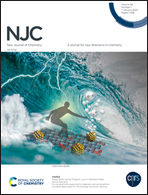Eu(iii), Tb(iii) activated/co-activated K2NaAlF6 host array: simultaneous approach for improving photovoltaic efficiency and tricolour emission†
Abstract
Rare earth-activated fluoride phosphors have generated attention in recent years in the field of solid-state lighting and solar cell efficiency enhancement. In the present study, RE (RE = Eu3+, Tb3+) activated/co-activated K2NaAlF6 phosphor was synthesized using a low-temperature wet chemical method. The photoluminescence (PL) properties of this sample were investigated using RF-5301 PC spectrofluorophotometer. The structural features of samples were analyzed using X-ray diffraction (XRD), which showed that the samples were crystallized in a well-known structure. Morphological studies of the prepared phosphors were conducted using a scanning electron microscope (SEM). Photoluminescence characterization of Eu3+, Tb3+ co-doped phosphor shows a blue emission at λmax ∼ 450 nm and three peaks at 544 nm, 588 nm and 614 nm at the excitation of 377 nm. This phosphor was then coated on a solar cell for efficiency enhancement. The efficiency of the phosphor-coated solar cell was measured under artificial radiation via an LED solar simulator and also under direct sunlight. The enhancement in the actual intensity of solar cells was observed to be 23.95% and 30.44% for artificial and direct solar illumination, respectively. The as-synthesized phosphor shows a broad emission spectrum in the visible region, this might make it a potential candidate for WLEDs and the reason behind solar cell efficiency enhancement. Hence this material being a broad spectral converter is suitable for next-generation solar cells.



 Please wait while we load your content...
Please wait while we load your content...